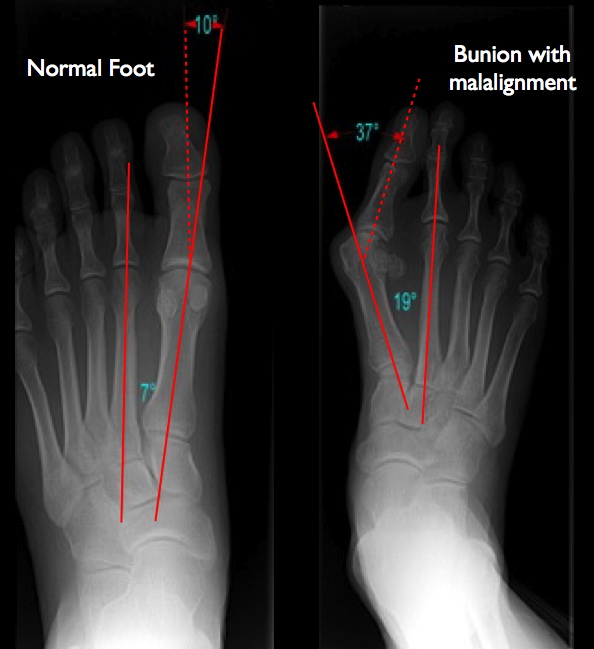Bunion (Hallux Valgus)
The term bunion refers to a deformity of the big toe in which there is an apparent enlargement or bump over the inner aspect of the great toe. It is not a "growth" that occurs, but rather a malalignment the foot that causes a prominent bump on the inside of the big toe.
This is a common and disabling deformity in which the patient experiences pain when wearing shoes. Occasionally intermittent numbness in the area of the great toe is experienced. Chronic thickening of the skin with irritation over the bunion is common. Occasionally the skin can break down in this area, resulting in and infection.
Why a bunion develops is not completely understood. In most cases, it is probably due to poor footwear. This is referred to as an Acquired Bunion. Over 90% of bunion surgeries are in females. The reason for this is that women are more likely to wear poor shoes (mainly high heeled shoes with pointed toes). Acquired bunions typically occur in the women 40 years or older.
Notice how this pointy toed shoe forces a normally aligned foot into and abnormal posture resulting in a bunion deformity. Over time, pressure on the great toe from these types of shoes will cause a bunion deformity.
It is also known that bunions run in families and we often see grandparents, parents, and children in the same family with bunions. This indicates that there is a genetic predisposition to having a bunion. These bunions are referred to as Hereditary Bunions. These bunions will be present in the teenage years and worsen into adulthood.
Making the distinction between acquired bunions and hereditary bunions is very important and takes a great deal of diagnostic skill. It is important is that it changes the surgical plan significantly. If the wrong surgery is performed because of the wrong diagnosis, then a recurrence of the bunion is common.
The goal of treatment of a bunion is to relieve pain. It is not to correct a cosmetic deformity. In early bunion deformities, the use of shoes with a wide toe box to minimize pressure over the bunion is the treatment of choice. As the deformity progresses, surgery may required to correct the deformity. There are many different types of bunion repairs designed for different foot deformities. Further discussion about surgical repair is completed prior to scheduling surgery. The main point is if a bunion doesn't hurt, there is typically no need to fix it.
Following surgery, careful postoperative care is need in order to keep the toe and metatarsal in proper alignment. Frequent office visits are necessary to inspect the incisions and to re-wrap the foot in a corrected fashion. This is accomplished with a compression dressing with toe strapping will be used for 8 weeks and the patient will use a bunion shoe to walk in during this period of time.
Below is an example of before and after clinic photographs and radiographs.




